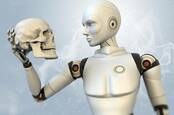This article is more than 1 year old
Give 1,000 monkeys typewriters, they'll write Shakespeare. Give them robot arms, and wait – they actually did that?
Animal-piloted cyborgs is just what 2017 needs right now
Amputee monkeys have been trained to control robotic arms with their minds using an advanced brain-computer interface, a group of researchers has claimed.
A paper published in Nature Communications on Monday describes an experiment with three Rhesus macaque monkeys (Macaca Mulatta) that were previously involved in accidents and had to have an arm amputated.
Electrodes were implanted to the monkey’s heads in the area where the primary motor cortex is located - an area of the brain that controls movement - and then to the severed limb. For two of the animals, the electrodes were placed on the opposite side to the amputated arm, and for the other monkey the electrode was on the same side as the injury.
The monkeys were coaxed into moving the robot arm to reach and grab a ball, incentivized with sips of sweet juice as a reward. The robot prosthetic isn't directly connected to the monkey (a la Silicon Valley), but instead is linked to the computer that processes signals from the electrodes. When the signal for moving the limb is activated, the robot arm moves as well.

If you can't beat AI, join it: Boffinry biz baron Elon Musk backs brain-machine interface biz
READ MOREThe electrodes measured the activity of the brain’s neurons to see how connected they were to one another before and after the training. The results show that the connections between the neurons on the opposite side of the amputated arm were sparse before training as the absent limb was rarely exercised – the right side of the brain controls the left arm, and vice-versa. But as the monkey was trained, the connections in the brain’s area used to make the robot arm reach and grasp became more dense.
But for the neurons on the same side of the amputated limb, the behavior was reversed. The connections between neurons started off strong, and were pruned over time to build a new, dense network of cells for muscular control. The neurons were reordered, basically.
Karthikeyan Balasubramanian, who led the study and is postdoctoral researcher at the University of Chicago, said the strength of the connections “were shedding off as the animal was trying to learn a new task, because there is already a network controlling some other behavior. But after a few days it started rebuilding into a new network that can control both the intact limb and the neuroprosthetic."
Nicho Hatsopoulos, co-author of the study and a professor of organismal biology at the University of Chicago said that the study shows long-term amputees can learn to control robotic limbs.
"[What’s] interesting was the brain's plasticity over long-term exposure, and seeing what happened to the connectivity of the network as they learned to control the device. That's how we can begin to create truly responsive neuroprosthetic limbs, when people can both move it and get natural sensations through the brain machine interface," he added.
The researchers hope that this will one day be applicable to humans. "The brain and nervous system of the monkeys are very similar to humans, so this research is like a proof of concept for humans. One day the same technology can be used to help human amputees control robotic prosthetics with the brain," a spokesperson told The Register. ®
Bootnote
The 1,000 monkeys reference is, of course, a Simpsons joke. The infinite monkey theorem is here.
